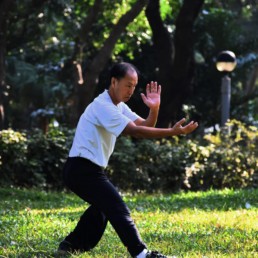
European and American physicians wrote these alternative therapies off as ineffective, and they rarely encouraged patients to include them as part of a comprehensive treatment plan.
However, over the past 20 years, a number of in-depth studies have looked at whether and how Chinese wellness techniques can complement modern medicine, and the results are startling.
The evidence shows what Chinese practitioners knew all along – these methods improve outcomes for individuals who are managing chronic conditions or fighting deadly diseases.
Tai Chi and Qigong have been shown to have particular benefits for patients who are receiving treatment for cancer.
Many physicians are now urging patients to practice these traditional Chinese therapies in an effort to reduce the impact of cancer symptoms and treatment side effects, as well as to improve the effectiveness of modern cancer treatments.
Introduction to Alternative Therapies
While Qigong and Tai Chi are often practiced together, they are separate disciplines that share an underlying philosophy. In combination, they offer powerful benefits for the mind, body, and spirit.
What is Qigong?
The word “Qi” means “subtle breath” or “vital energy”, and “Gong” means “improving skills through steady practice.” Together, they form Qigong, a system of wellness that is deeply woven into the Chinese way of life.
The Chinese National Health Plan incorporates Qigong, and its practice is standard in primary schools, secondary education, hospitals, and workplaces.
There are an endless number of interpretations by masters, teachers, and schools, but the underlying principles are the same.
Qigong benefits every aspect of personal health, touching body, mind, and spirit. It integrates deliberate movement, controlled postures, breathing techniques, self-massage, and sound, all surrounded by the focused intent of the practitioner.
What is Tai Chi?
One could think of Tai Chi as a descendent of Qigong, as it was developed after the introduction of Qigong.
It is a martial art that incorporates Qigong principles into a series of fluid movements and forms.
The system was originally intended for combat and self-defense, though in modern Western culture, it is primarily used for physical fitness.
Essentially, Tai Chi aims to integrate mind and body, and practitioners learn the skills necessary to control movements and breathing.
This generates energy, serenity, and mindfulness, and according to the Chinese philosophy, it allows life energy to flow smoothly and powerfully through the body.
Tai Chi integrates the inner and outer self by bringing the mind and body into harmony.
As the health benefits of Tai Chi and Qigong become more clear through research, many people are incorporating practice into their daily fitness routines. More importantly, physicians are realizing the value that these complementary therapies contribute to treatment of chronic and serious disease.
The Health Benefits of Qigong and Tai Chi for Cancer Patients
The health impact of Qigong and Tai Chi practice have been studied extensively in recent years, and research shows an array of benefits.
Many of these benefits offer particular support for cancer patients, as the side effects of cancer treatment can be nearly as debilitating as the disease itself. Examples of Qigong and Tai Chi benefits include:
Improved Natural Healing Capabilities
It has been shown that the practice of Qigong and Tai Chi can alter a patient’s neurochemistry profile, promoting the body’s ability to leverage its natural healing mechanisms.
Neurotransmitters are released to bond with receptors in the body systems, for example the nervous system and the immune system, to reduce anxiety and depression, bring pain levels down, and decrease addictive cravings.
Better Immune System Function
Through the practice of Qigong and Tai Chi, many patients experience improved immune system function.
The techniques have been shown to activate immune cells and increase the rate and flow of lymphatic fluid.
Toxins are flushed from the tissues, organs, and glands through the lymphatic system, so the body is better able to resist infection and disease.
Enhanced Cell Metabolism and Tissue Regeneration
Because Qigong and Tai Chi increase blood circulation, more oxygen and nutrients reach the brain and other vital organs.
Muscles and tissues also get a boost in oxygen and nutrients, which supports the ability of cells to regenerate.
Greater Flexibility and Balance
Tai Chi is a very gentle form of movement. Among other things, it is designed to stretch muscles and improve mobility in joints, which is critical to overall flexibility.
Better still, Tai Chi increases balance, reducing the risk of falls. This is important for cancer patients who often find that the neuropathy and weakness associated with their cancer treatment puts them at greater risk of falling.
Because Tai Chi is so gentle, most cancer patients are able to participate in the standard practice or a modified version of the movement activities.
Decreased Stress
Qigong and Tai Chi, whether practiced individually or in combination, directly reduce levels of stress by moving the body and mind to a relaxed state.
Both are designed to free the mind from distractions. When successful, the sympathetic function of the autonomic nervous system decreases, and reducing heart rate and blood pressure.
The blood capillaries dilate, improving the flow of oxygen and nutrients to body tissues.
Reduced Pain
As practitioners move through Qigong and Tai Chi rituals, the function of the hypothalamus, pineal, and pituitary glands is moderated, and the cerebrospinal fluid system that moves messages from the spine to the brain and back becomes calmer. This reduces pain and improves mood, for better overall well-being.
Changes in Brain Waves
Because Qigong and Tai Chi promote relaxation, they induce alpha – and occasionally theta – brain waves.
These brain waves are neither slow nor fast. They offer a state of calm focus, which is marked in the body by a lower heart rate and decreased blood pressure.
For some cancer patients, this means relief from “chemo-brain” – the ever-present fuzziness that accompanies chemotherapy treatments.
Higher Quality Sleep
Pain and discomfort can make sleep elusive. Fortunately, Qigong and Tai Chi work to improve sleep quality.
As mentioned, the practice of these skills reduces pain, but it also helps with balancing and coordinating the right and left hemispheres of the brain.
With greater coordination in the brain’s hemispheres, many patients experience greater mental clarity, less anxiety, and deeper sleep.
These benefits are helpful in improving quality of life under any circumstances, but they are particularly helpful for patients experiencing the symptoms and side effects of cancer and cancer treatments.
The Impact of Qigong on Cancer: Study Results
In the past two decades, there have been multiple studies examining the effects of Qigong on cancer.
A 2013 report out of Guangzhou Medical University in Guangzhou, China, reviewed all of the results up to that point, then published a comprehensive set of conclusions that influenced how today’s cancer experts look at treatment.
In short, the researchers determined that based on the evidence collected through multiple studies, Qigong and Tai Chi have a positive impact on quality of life for cancer patients.
Specifically, the practice of these therapies eases the fatigue often experienced during cancer treatment, and it improves immune function and cortisol levels in cancer patients.
This work prompted additional research into Qigong’s effects on cancer, and many more studies have been conducted since. Examples include the following:
- Qigong/Tai Chi for sleep and fatigue in prostate cancer patients undergoing radiotherapy (2016) –
- Many patients who are undergoing radiotherapy for prostate cancer report trouble sleeping and deep, on-going fatigue. This study determined that the practice of Qigong and Tai Chi during radiation treatment allowed patients to sleep better while going through the radiation treatment process.
- Ameliorative effects of Tai Chi on cancer-related fatigue (2018) –
- Practicing Tai Chi for eight or more weeks has a positive impact on cancer-related fatigue (CRF).This is particularly true for patients with breast cancer or lung cancer.
- Specifically, the study shows Tai Chi offers a greater benefit for patients than physical exercise and psychological support alone.
- The effects of Tai Chi on quality of life of cancer survivors (2019) –
- The practice of Tai Chi was shown to improve both physical and mental aspects of quality of life in cancer patients. It contributed to better sleep, reduced cortisol levels, decreased corticotropin releasing factor (CRF) levels, and enhanced limb function.
Certainly, further exploration and study is needed to discover the breadth and depth of benefits available from Qigong and Tai Chi, but so far, the evidence is clear: Qigong and Tai Chi offer meaningful improvements in quality of life for cancer patients.
Are Qigong and Tai Chi Right for You?
While it is difficult to make a blanket statement that any form of therapy is right for all patients, the fact is that the principles of Qigong and Tai Chi have potential to benefit everyone who practices.
Your physician and your Qigong professional can offer guidance on how to adapt your practice to your current situation, but it is safe to say that practicing the breathing techniques and exploring focused attention and mindfulness are appropriate in nearly every circumstance.
Check with your health care provider before participating in deliberate movement and controlled postures, and consult with your Qigong teacher to determine how these can be modified to meet your needs.
How Do I Get Started With Qigong?
If your physician doesn’t offer Qigong resources, don’t worry. There are many ways to start your practice in your home and in your community. A quick search online can virtually connect you with some of the most respected Qigong masters in the world, giving you an opportunity to learn the basic principles right away.
Virtual learning is a good way to begin your understanding of Qigong, but an in-person experience is best for realizing the full array of benefits.
Fortunately, a variety of practitioners offer one-on-one therapy that is carefully designed to meet your individual needs.
You can find providers and teachers in your area who specialize in Qigong through the Qigong Institute’s online directory.
If your health permits you to participate in classes and group events, you can get a lot of value from a community program. In a group setting, you have an opportunity to connect with like-minded people, building your circle of friendship and support.
More experienced students will help you improve your skills, and you can share what you have learned as new students join the group. Visit Qigong Hub for a listing of Qigong classes and events in your area.
What’s Next?
About the author

